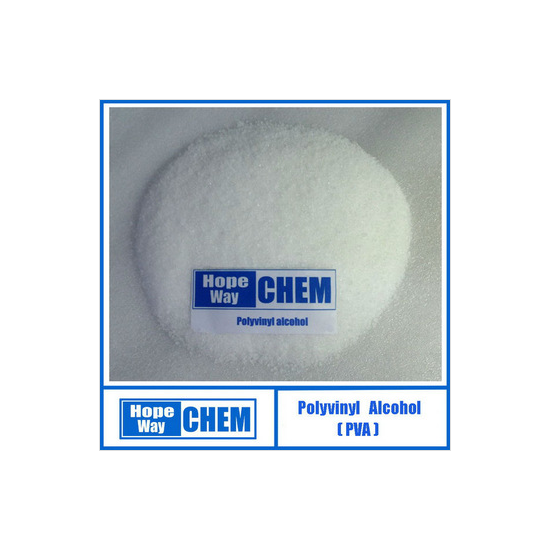- Home >> Polyvinyl Alcohol(PVA) >> PVA supplier PVA BP17

HOPE WAY CHEMICAL POLYVINYL ALCOHOL
Introduction
Polyvinyl
Alcohol (PVA) is a water soluble and biodegradable synthetic polymer. It is a
dry solid, and is available in granule and powdered forms. Grades include both
fully hydrolyzed and partially hydrolyzed. PVA is an excellent adhesive with
superior bonding strength, film forming and emulsifying properties. The film of
PVA exhibits outstanding resistance to oil, grease and solvents. In addition to
its film forming property, it has excellent adhesion to both hydrophilic and
hydrophobic materials. PVA has been extensively used in textile industry for
warp sizing and resin finishing; in paper industry for surface sizing and
pigment coating; in the production of PVAc emulsion as protective colloid; in
the suspension polymerization of PVC as a dispersion agent; as binder for ceramics,
magnet, foundry cores and pigments.
PVA is manufactured by polymerization of vinyl acetate monomer, by
hydrolysis of the polyvinyl acetate. HOPE WAY PVA is produced in a wide range
of hydrolysis and polymerization. In the partially hydrolyzed grades, 86-89
mole% of acetate group is replaced by alcohol group. Likewise, in the fully
hydrolyzed grade, 98.5~99.2 mole % of acetate group is replaced by alcohol
group.
Individual
PVA grade varies in molecular weight (degree of polymerization) and degree of
hydrolysis. In order to help our valued PVA users to choose the most
appropriate grade, HOPE WAY has defined HOPE WAY PVA grade as following:
HWF-17: Fully hydrolyzed PVA with degree of polymerization about 1700.
HWP-20: Partially hydrolyzed PVA with degree of polymerization about 2000.
The most important properties which the majority of applications depend are
degree of polymerization and degree of hydrolysis. The degree of polymerization
is an expression of the size of polymer. The higher the degree of
polymerization of polymer is, the bigger the size and the longer the length of
polymer is. Similarly, the degree of hydrolysis is an expression of the ratio
of hydrophilic alcohol group and hydrophobic acetate group.
The properties of PVA are summarized as follows.
1. Based
on degree of polymerization
■ The higher degree of polymerization of polymer is, the higher viscosity of
solution and adhesion strength of film are.
■ The higher degree of polymerization of polymer is, the less water solubility
and the higher solvent resistance are.
■ The higher the degree of polymerization of polymer is, the higher tensile
strength of PVA film is.
■ The higher the degree of polymerization of polymer is, the less penetration
and softness of film is.
■ The higher the degree of polymerization of polymer is, the better protective
ability is.
2. Based on degree of hydrolysis- Dissolving properties
■ Fully hydrolyzed grade PVA (HWF type) can be easily dissolved in over 90°C
water, but it only swells in room temperature water.
■ Partially hydrolyzed grade PVA (HWP type) can be slowly dissolved in room
temperature water. But in normal uses, raising temperature to 90°C is necessary
for saving dissolving time.
■ Super low hydrolyzed grade PVA (HWC type) can be dissolved in 25°C to 50°C water, according to their grades.
■ Good affinity to hydrophilic fiber such as cotton, rayon and paper.
■ Better water resistance film property than HWP type PVA film.
■ Viscosity is less stable in the condition of low temperature and high concentration than HWP type PVA.
■ Dissolving rate is slower than HWP type PVA
4. Characteristic of HWP type PVA
■ Good affinity and cohesion power to hydrophobic fiber such as polyester,
nylon, polyester /cotton blended and polyester/ rayon blended fiber.
■ Good compatibility with oiling agent.
■ Good solution viscosity stability.
■ Better protective colloid property than HWF type PVA
Grades and Specifications
1.
Standard Grades
| Viscosity (cps) |
Hydrolysis (mole%) |
Volatile (wt%) |
Ash (wt%) |
PH |
|
| Fully Hydrolyzed |
|||||
| HWF-03 |
3.0-4.0 |
98.0-99.0 |
≤5.0 |
≤0.5 |
5–7 |
| HWF-04 |
4.0-5.0 |
98.0-99.0 |
≤5.0 |
≤0.5 |
5–7 |
| HWF-05 |
5.0-6.0 |
98.0-99.0 |
≤5.0 |
≤0.5 |
5–7 |
| HWF-08 |
8.0-10.0 |
98.0-99.0 |
≤5.0 |
≤0.5 |
5–7 |
| HWF-14 |
13.0-16.0 |
98.0-99.0 |
≤5.0 |
≤0.5 |
5–7 |
| HWF-17 |
21.0-26.0 |
98.0-99.0 |
≤5.0 |
≤0.5 |
5–7 |
| HWF-17H |
28.0-32.0 |
98.0-99.0 |
≤5.0 |
≤0.5 |
5–7 |
| HWF-20 |
34.0-42.0 |
98.0-99.0 |
≤5.0 |
≤0.5 |
5–7 |
| HWF-24 |
48.0-60.0 |
98.0-99.0 |
≤5.0 |
≤0.5 |
5–7 |
| HWF-26 |
60.0-75.0 |
98.0-99.0 |
≤5.0 |
≤0.5 |
5–7 |
| HWF-28 |
75.0-90.0 |
98.0-99.0 |
≤5.0 |
≤0.5 |
5–7 |
| Partially Hydrolyzed |
|||||
| HWP-03 |
3.0-4.0 |
86.0-89.0 |
≤5.0 |
≤0.5 |
5–7 |
| HWP-04 |
4.0-5.0 |
86.0-89.0 |
≤5.0 |
≤0.5 Previous:Polyvinyl Alcohol Introduction Next: polyvinyl alcohol auxiliary 1799 2499 PVOH PVA MANUFACTURER Product Categories
| |



